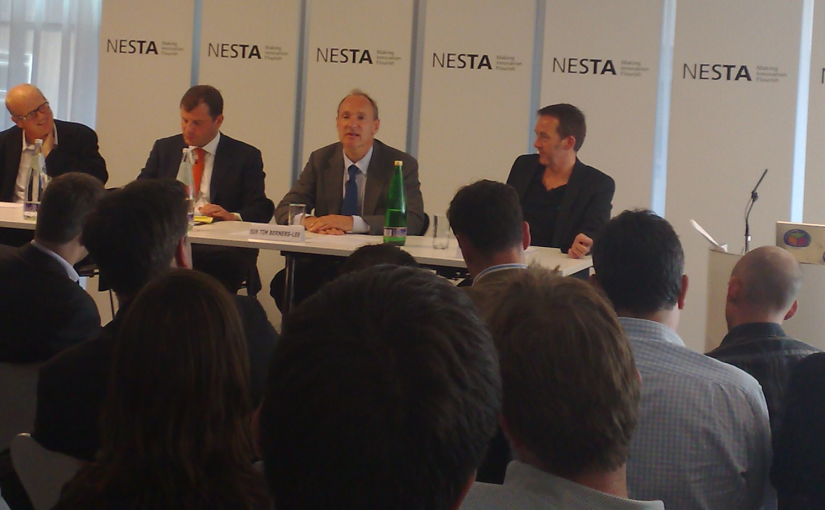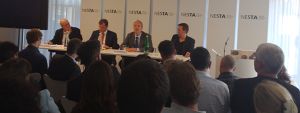[My very rough notes, I've been distracted and missed bits, probably misheard things, etc, but at least it gives people who weren't there an idea of the flavour of the event.]
[Update – the video is online, you may find that easier to digest.]
Max Anderson, director of the Indianapolis Museum of Art – opening plenary at Museums and the Web 2009, 'Moving from virtual to visceral'.
Behind the applications we're producing, for an art museum in particular, we're looking for something beyond exposure to things. Felt, deep, elemental emotions.
Museums tend to define selves in terms of number of objects, acres, visitors… difficult to translate that endeavour online in a way that sticks. If you get too caught up in plumbing of technology, you forget about the outcomes. "In addition to bragging rights, what features of a museum should be online?"
[missed bits]
So much of what goes on behind scenes is critical to experience of front of house, give visitors an experience of that behind the scenes stuff.
Volunteers are important. Enormous swathe of public who could be continually engaged…
Review of what happens on site in museums: flirting, gossiping, looking, shopping, eating. Looking is wedged among all other activities. Is it heresy to admit that looking and learning are only a small part of a museum visit?
George Hein, visitor survival curves… pathways through museums. Opportunities to construct a narrative – but this isn't the normal approach to museum attendance. Choice and opportunity should govern what happens, rather than doing what we think the public demands.
Average time in front of a work of art is 3 seconds, it's 'glancing at picture to confirm that's what you've just read about' on the wall label. There are precious few moments when people linger in front of objects – it's like the Museum of Drag Racing. But look at the percentage of time learning versus that spent living in university. So much of time in college is extrinsic to learning. Give permission for that kind of experience in institutions, make a bond with visitors that's visceral, not just virtual.
Excessive orientation can compromise the experiential/learning environment.
There's too much clutter in experiential terms, we're torn constantly by stimuli. 'Virtual' museum programs – we fall in love with the technical solutions, but it's not obvious that they have the intended effect, and are also good for audiences.
An interactive map is still a map – show what's behind the velvet rope, it's sensual, appealing.
Databases – data cleaning before putting things online vs put everything online now and see how much have to clean up. Publishing databases about collections is just a baseline, just the beginning of something. Having high resolution images is, for lots of visitors, not much better than credits at the end of a movie. It's necessary, but not sufficient. We've only gotten to building the ground floor – we need to take visitors to the whole movie, get beyond showing them the credits.
Eschew the virtual, promote the visceral. What we collect has stories behind it, telling the stories is the key issue. What are the avenues for achieving something visceral in a museum visit?
Suspend commercial intrusion and attempts at mind control. Bruegel King.
Privatisation takes away the possibilities of adventure and play. Encourage voyeurism – show staff in action. Public wants to see how museums operate and function. CSI is a hit because it shows what goes on behind police work. We should take a cue from that appetite and enthusiasm.
[Missed a bit]
People enjoy being near original objects. Revel in the thrill of proximity to the original object.
Foster projection into another time, place or condition.
Disorient visitor, give them permission to move away from comfort zone. Encourage playtime, dream time.
Help visitors savour and retain memories and empathetic response. The empathetic response is the memory maker.
Help visitors apply that memory and empathetic response to daily life. Take the lesson embedded in museum objects, find the link to continued application to life after you've left the museum. Extensions of learning beyond what happens on site.
Teach now to practice connoisseurship at the mall – aesthetic standards around quality, etc.
Preferable scenario to onsite orientation – use pre-visit planning and post-visit environment. Encourage visitors to get ready before visit online beforehand. Kids who come on school visits to the Indianapolis Museum of Art get memberships for families, they can come back and share their learning with their parents.
Pre-visit – choose a path based on visit duration or thematic interest. Wander through the museum behind the scenes online. Show how complicated it is to run museums, "not as simple as switching on the lights and admiring things". Sharing this is useful, particularly given current climate.
On-site: deviate from planned path, improvise. The visitor doesn't need to be tied to our taxonomies. Make room, permission for visitor to experience it that way.
Post-visit – join Facebook, etc. We want to be part of your lives, not just a visit.
Encourage participation by telling the truth, the whole truth and nothing but the truth. We've been good at promoting and marketing and cheering ourselves on but not necessarily good at telling the truth.
It's about shining a light on how far you've got to go, not just what you've got to show off.
IMA had layoffs, their dashboard showing employee count dropped. If a museum has more people in development than in education or interpretation, then is bereft.
One of the truths we need to get out to visitors… permanent collection isn't permanent. Refreshment of new works of art on view. Objects are not permanently on display, they're in storage, lent, borrowed. Rhythm [of display, I think]. Permanent collections are invitational as well.
Attendance figures – "we don't necessarily think that's true but that's the number we quote". Is it a clicker with guards, estimates?
Mapping visitors by postcode, what postcodes aren't represented? Did he just say 'statistical porn'??
Making institutions more a part of your life, talking about collections. Also showing deaccessioning. Policy on deaccessioning on web – 'a no brainer'. Also put up db of works planning to deaccession as well as ones have deaccession. He has the uncomfortable feeling that he shilling for deaccession but they're really just trying to be transparent about process. Next process is to link funds from deaccession to artworks acquired with funds from its sale.
Charity Navigator. Don't trust what you see on the web. Methodology is flawed. We should present those stats ourselves, don't wait for someone else to be arbiter of our fortunes.
Why wait for someone else to publish your financial info, do it yourselves when it's ready.
Steve.museum – more empathetic. Opera in Italy in 19thC was riotous but now is antiseptic – don't make that mistake in museums.
Transcriptions, search terms is the magic of ArtBabble. Search results will take you to that second in the video. [Awesome!]
Click, Brooklyn Museum. Crowd-curated exhibition. Brooklyn Museum API – on screen, [missed stuff]. Te Papa. [Woo, check the love!]
Don't bet the farm on commercial applications that may go away.
[The end! I'll update when slides go online and tidy and correct if I can get more accurate info. Questions to come when I get a moment.]

